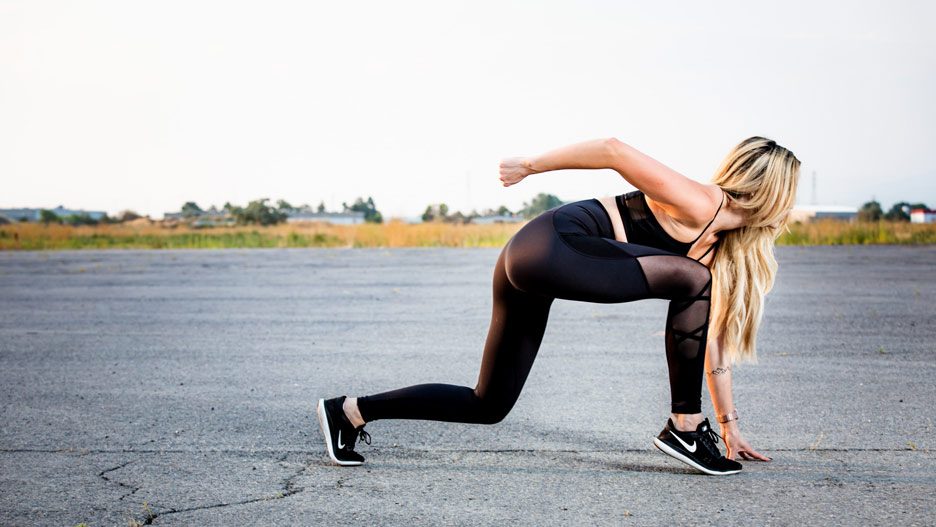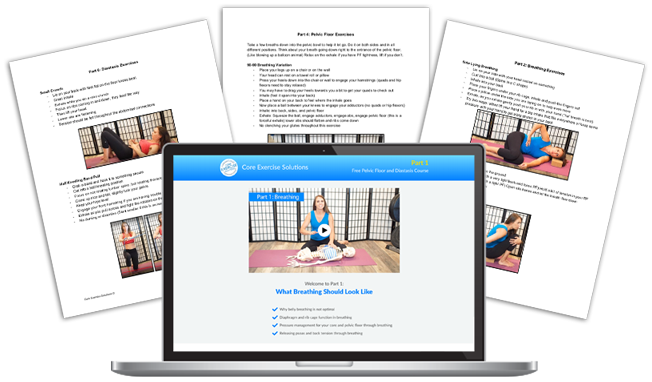A better question is should I run with a diastasis, and that answer is probably not in the beginning if it's a fairly severe diastasis, and maybe if it's mild -- BUT before you get upset with my advice, let me explain the why and help you figure out how to run safely. In a way that contributes to back, hip, or other aches and pains.
Telling a runner not to run is like trying to change my kids' minds when they were 3. Ha! Good luck with that. So, let’s dive in and see what we can do to get you strong enough to run safely since we all know you are going to run anyway. I get that there is a mental health reason to run.
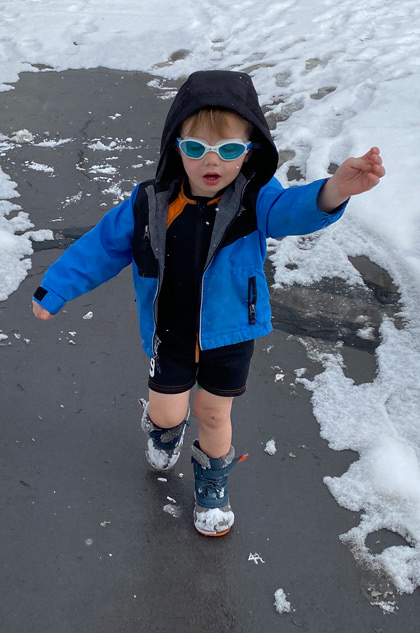
Why You Shouldn't Run With a Diastasis
First: Why you shouldn’t run. Let’s break down the science.
A diastasis is a thinning of the fascia in the front of your abdomen. When you think of fascia I want you to think about that shiny layer when you pull the skin off raw chicken. That’s fascia. It runs through your entire body, connecting and orchestrating movement. It’s very important and pretty cool!
The linea alba (midline fascia where you check for a diastasis) is made up of collagen. Collagen remodeling (i.e. healing) - both potential and rate will depend on a multitude of factors. Some in your control, like nutrition, hydration and the right amount of exercise stress, and some not in your control, like the amount of stretch the fascia endured and genetics. I've found that there are too many factors to use width and depth measurements of a diastasis to determine whether or not it will heal naturally or need surgery.
I’ve seen women who have a diastasis large enough to fit my fist into their gap heal it completely, but other women get frustratingly stuck with a small diastasis that doesn’t seem to want to heal at all. Severity is not always the best determining factor for who has healing potential. (Just a little food for thought.)
When you test your diastasis and your fingers squish all the way in to multiple knuckles without touching firmness, you know those TAs (deepest abdominal stability muscles) aren't connecting through the fascia in the front. This has nothing to do with width and everything to do with depth. (More specifics coming, just keep reading!)
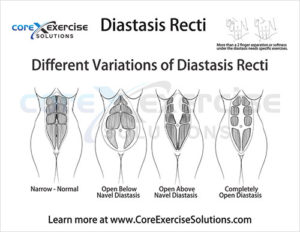
To repair itself, fascia doesn’t like to be under constant and/or excessive strain, which means your posture and alignment shouldn't add to that constant stress, especially if you are going to stress your body with a single leg dynamic activity, like running -- quadruply so, if you going to push a stroller.
There is no such thing as perfect posture but there are tendencies that seem to lead to more issues, and when these are corrected it can assist in diastasis healing. Maybe it's not the posture itself per se but the fact that our posture is a reflection of how our body likes to move. And, it's often the way we move that can make a big difference. I've seen people working on healing a diastasis doing "all the exercises" but not seeing any improvement. It's not until they make tweaks to HOW they are doing the exercises instead of WHAT we are doing that we start seeing the real improvements, even years later!
Another important factor to keep in mind is that if your diastasis is only tentatively healed -- meaning it feels firm when you lift your head, but you bulge when you do a plank or leg lift -- then running could (but not always) cause a healing regression because it’s not 100% fixed yet. It might not, but it is something to keep in mind.
Your core acts as a major stabilizer of your pelvis when you run. With a diastasis, your ability to load your core becomes ineffective, which means decreased pelvic stability. (Picture your pelvis as a suitcase in the middle of a truck bed, and your core muscles are the ropes holding it in place. With a diastasis, it’s like untying one of those ropes. That suitcase (pelvis) is not going to be held strong and stable in the middle.)
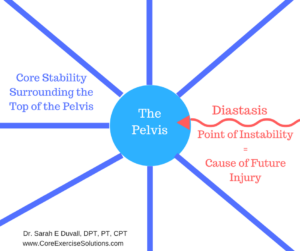
Without pelvic stability, injury is more likely to occur, such as IT Band syndrome, knee pain, hip pain, Achilles tendonitis, plantar fasciitis, back pain, and neck and shoulder tightness. Wow! That’s a lot of potential issues from one “loose rope,” but the thing is, our body needs balance to make sure everybody pulls their weight to not overload one area too much. If not, someone (a joint/muscle/ligament/etc.) will get more wear and tear than everyone else and will start screaming at you, often in the form of pelvic floor leaks, butt or hip pain, low back tightness… you get the picture.
Running is a repetitive activity and repetitive activities are the ones most likely to lead to orthopedic issues.
Correct running form utilizes the entire core and glutes, but with a diastasis, you may not transfer energy well across the front and can be more likely to load the connective tissue, instead of your entire core muscular system. (Think of it as the weakest link in the chain, and the body loves to exploit a weak link by following the path of least resistance. When it can hang on connective tissue instead of using muscle, it usually does. Using muscle burns calories, if we go back to when food was scarce and calorie conservation could mean life or death, our bodies adapted to conserve energy and rest whenever possible. It didn't matter if you hung on fascia and ligaments, life expectancy was 30-35. Yikes, that puts my ripe old age in perspective!)
Movement Mechanics That Can Make A Diastasis Worse
Let's take a closer look at your movement mechanics.
- Does your head come forward?
- Do your shoulders hunch?
- Does your bottom tuck under or stick way out?
- Are your ribs flared or do you grip them down?
- Do you have a slight forward lean with a cheetah-like gait? (not speed just posture)
These poor mechanics, often caused by lack of posture awareness, poor alignment or simply general weakness. This can cause excessive stress when running.
One of the biggest questions I love to ask someone is "how do you feel post-run?" This is the most telling question!
How Do You Feel Post-run?
Do you feel amazing with all your muscles feeling loose, warm and awesome?
- Or do your neck and shoulders feel tight post-run? This tells us your breathing wasn't best while running. Breathing is probably the biggest influencer for core and pelvic floor healing and performance.
- Do you feel like you need to stretch your quads? If so, this tells us that you might not have had great glute balance on your run.
- Do your calves feel tight? This could mean your arches are weak and need some strengthening.
Some muscle tightness post-run is normal, especially if running isn’t something you do regularly. What we’re looking for here is something that feels more than normal. Something that feels like it may lead to pain down the road.
There are lots of other telling "checkpoints" post-run but the idea is that you should feel good post-run, not worse.
Running should not make you feel like you're turning into an old lady with aches, pains and tightness after!!
Okay, back to why you should think before you run with a diastasis recti (DR) (especially if it's severe).
If a DR is persisting and not improving, that tells me something with your alignment that might not be working for you, and the muscles in your core and hips might not be working together in an optimal way or your breathing could use some improvement.
When you overload alignment that strains the fascia-- and running is overloading big time -- it sets you up for more injuries down the road. When you overload great alignment and strength it just feels great after!
The Band-aid Approach
These are the women I see where they want just enough to fix the one thing that’s bothering them. They don’t want to take the time to fix the source of the issue. That’s where this “warning light” from the body in the form of a DR comes in. What's the true cause of your DR?
“And I don’t mean what they were doing the moment before the ailment happened. Fixing DR is the same as anything else. It is not a situation caused by pregnancy, or a giant baby. It is caused by carrying high pressure in the abdomen. Trying to do exercises to fix a pressure-induced issue while continuing to hold your body in a way that continues to create high pressure will never work.” Katie Bowman
Preach it, Katie! Preach!
In all likelihood, the cause is not what you think. It’s deeper, a lot more integrated, and certainly can’t be fixed with a small crunch trying to smoosh your abs together.
Try This Free Diastasis Recti Educational Series
Dr. Sarah Duvall, PT, DPT, CPT, and the CES Team have helped thousands of women create the strength and stability needed to overcome diastasis recti and build core strength.
Join us today for this 4-part Diastasis Recti Video Series, absolutely free.
We don't spam or give your information to any third parties. View our Terms of Use and Privacy Policy.
What Should You Do If You Want To Run But Have A Diastasis Recti?
So, what should you do if you want to run but have a DR? Well, at least now you know it could cause a lack of pelvic stability, which can lead to injuries down the road. If it were me, I’d spend some (don’t panic, I didn’t say all) of my running time working on the cause of the DR and building strength instead of doing cardio.
I did not say give up running or never run again! All I want is to keep you safe, healthy, and running for years and years and years past the ripe old age of 35...40...50....60...dare I keep going.
Correct Your Alignment And Building Strength To Run With A Diastasis
Order is important here. If you don’t correct how your body is showing up to do an exercise, strength training could just cause more imbalances and injuries. So, know the goal of the exercise. Where should you feel it? What should be working? It's all about how you do something, not what you do! (Ok, a little about what you do as well because you need the right amount of stimuli for fascial remodeling the right way.) I have a sneaking suspicion that if we correct your alignment and muscle intention, we might just fix that DR once and for all. Yay!!!
Running is a single leg dynamic activity. It’s HARD on our body. You need to be in great shape to run.
Okay, let me rephrase that.
You need to be in great shape to run without something feeling achy or tight.
Steps to Start Running With a Diastasis
Step 1: Develop some awareness around your alignment and what muscles you feel working when you do exercises.
Step 2: Fix your breathing. Deep 360 ribcage expansion is needed for diastasis closure. Shallow breathing, promoted by drawing in your belly button, will prevent you from keeping your diastasis closed long-term.
Step 3: Test your strength to see if you're strong enough to run. Running is hard and demanding on our muscular system.
Step 4: Fix your everyday movement patterns. Learn how to bend, twist, and reach, stressing your core the right way. A good diastasis recovery program (whether online or in-person) should go over this. Everyday movements can be more important than exercises.
Step 5: Learn how to progressively load. Once my ladies get their ribs in, they learn how to breathe and move. Then, we move onto progressive front loading (i.e. being able to do a plank). A plank from the floor is not a safe exercise for a diastasis until you have trained the core how to do it. Think about pushing a stroller. That’s a lot of “planking” in an upright position, especially if you are pushing it uphill.
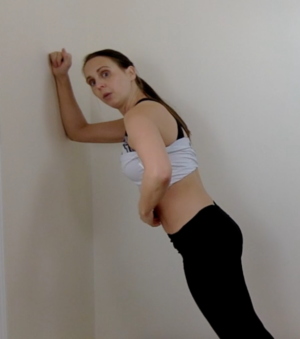
Step 6: Get stronger making sure all your muscles are working like they are supposed to. Example: Let’s take a simple bridge. A bridge should come from your glutes (butt muscles) but a lot of my clients feel it in their quads (front of their legs) and low back (paraspinals) and this makes their issue worse. Instead of doing a bridge to help their diastasis, they are actually keeping it from healing. Gasp!! Some exercises are better than others, but it’s how you do them that matters most.
P.S. You should be able to do single leg bridges keeping your hips at the same level. That's a minimal level of hip strength for running.
Another great one to try is a standing glute squeeze. Can you get those glutes to kick in?
Step 7: Check your running alignment. Do you have a great forward lean with your ribs stacked over your hips for efficient breathing?
Assessing rib flare can be a great start for looking at this.
Step 8: Then progress into running. Start slow. Not slow speed, just mileage. Don’t try to run 6 miles your first time out. Then please, please, please keep getting stronger!!! Running creates muscle imbalances. Those imbalances fuel injury down the road. Getting stronger and staying strong is the best preventative measure!
Find someone awesome to help you recover. Make sure they are looking at how your entire body moves and not just giving you a couple exercises. If you can’t find a good in-person physical therapist in your area, or if it’s too hard to go in for appointments, check out my online program for fixing a diastasis. It’s pretty awesome, and we cover all 8 of the steps above thoroughly.
One other thing that I find very helpful for both healing of a diastasis and optimizing running form is great serratus strength. This really helps with neck and shoulder tightness.
Just to recap. I did not say abandon running forever, so don't freak out. I simply want you to be smart about it and approach it like you would any dynamic exercise, with a strong, connected body!
Oh, and if you think this is an issue that is reserved just for postpartum women, think again my friend. This article will be of particular interest to you. Spoiler alert! Men get it, too: A Fascinating Look at 2 People with Tummy Bulge and Diastasis
Are you a professional that helps women and wants to gain the most in-depth knowledge possible on recovery exercises? Join us for the Postpartum Corrective Exercise Specialist Certification!
Working with pregnant and postpartum clients/patients?
This 6-part course offers key takeaways on breathing, pelvic floor strengthening and diastasis recovery. Sign up and start learning today!

